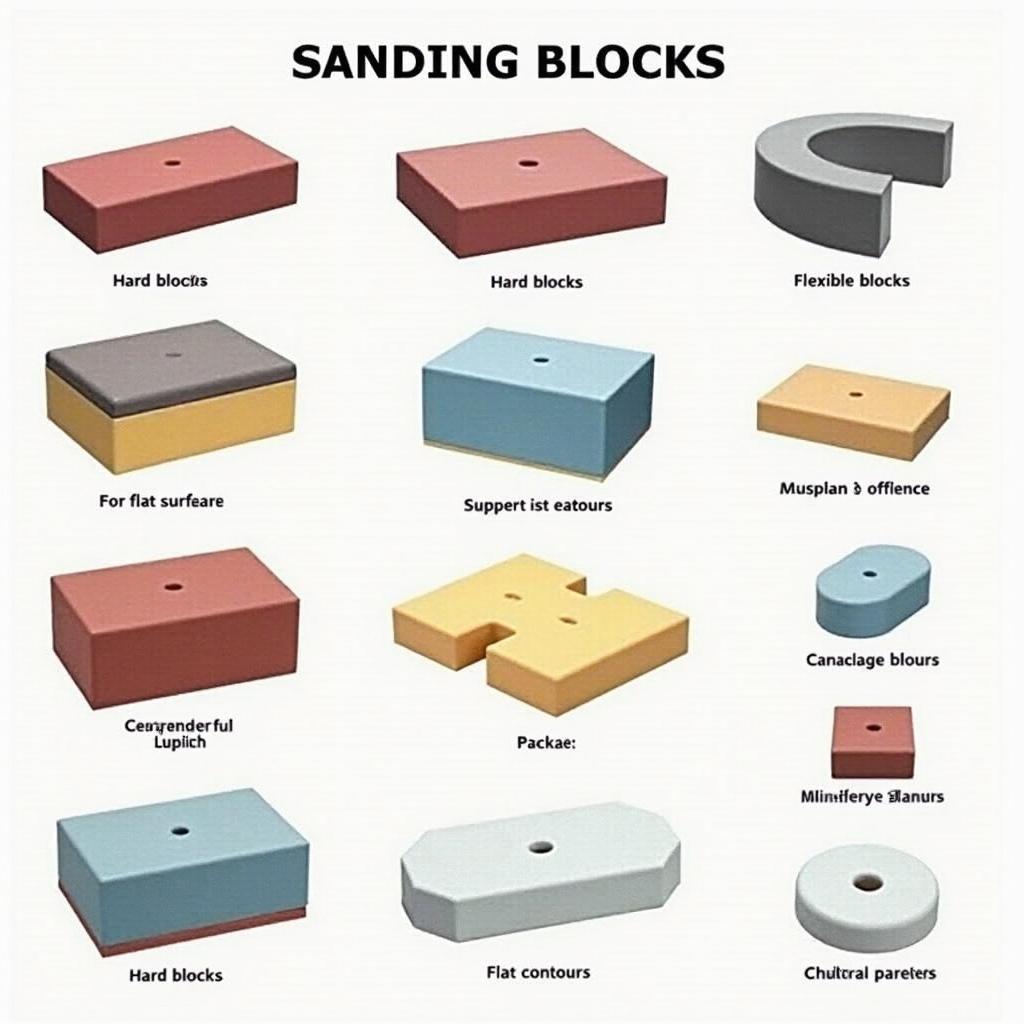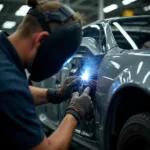When it comes to achieving a flawless finish in car body repair, sanding blocks are non-negotiable. These essential tools are the key to smoothing out imperfections, creating a uniform surface for paint adhesion, and ultimately, restoring your car’s exterior to its former glory. But with the variety of sanding blocks available, choosing the right one for the job can seem daunting. Fear not, this comprehensive guide will equip you with all the knowledge you need to make informed decisions about car body repair sanding blocks.
Understanding the Importance of Sanding Blocks in Car Body Repair
 Different Types of Sanding Blocks
Different Types of Sanding Blocks
Sanding blocks, unlike sandpaper used by hand, provide a consistent and even surface area for sanding. This helps avoid uneven pressure that can lead to dips or scratches in the body filler or primer. They offer better control and accuracy, crucial for achieving a professional-looking finish in car body repair. Whether you are smoothing out body filler, feathering paint edges, or preparing your car for a new paint job, the right sanding block can make all the difference.
Choosing the Right Sanding Block: A Deep Dive
Navigating the world of sanding blocks can be confusing, but understanding the key factors can help you choose the perfect tool for your specific needs. Here’s what you need to consider:
1. Types of Sanding Blocks: Matching the Block to the Task
- Hard Blocks: These rigid blocks are ideal for sanding large, flat surfaces and are commonly used during the initial stages of bodywork to level out body filler and smooth rough patches. They provide excellent control and ensure a uniform surface for the next stages of repair.
- Flexible Blocks: As the name suggests, these blocks are designed to conform to curves and contours, making them perfect for sanding areas like fenders, bumpers, and other non-flat surfaces. Their flexibility allows for efficient and even sanding without damaging the car’s body lines.
- Specialty Blocks: Designed for specific tasks, these blocks come in various shapes and sizes. From small profile blocks for tight spaces to contoured blocks that mimic specific car parts, these tools provide precision and control for detailed sanding work.
2. Grit: Determining the Coarseness for Each Stage
Just as important as the type of block is the grit of the sandpaper. The grit number indicates the coarseness of the sandpaper, with lower numbers indicating a coarser grit and higher numbers representing a finer grit.
- Coarse Grit (40-80): Used for the initial stages of sanding, such as removing rust, shaping body filler, or stripping old paint. This grit level is quite aggressive and should be used with caution to avoid damaging the car’s metal.
- Medium Grit (120-240): Ideal for smoothing out the surface after using a coarse grit, feathering paint edges, and preparing the surface for primer. This range offers a good balance between speed and smoothness.
- Fine Grit (320-600): Primarily used for final sanding before painting, this grit level creates a smooth, almost polished surface that allows for excellent paint adhesion. It ensures a professional-looking finish and minimizes the appearance of any imperfections under the paint.
3. Material: Durability and Performance in Focus
Sanding blocks are made from various materials, each offering different levels of durability and performance.
- Rubber: Durable and long-lasting, rubber sanding blocks are a popular choice for both professionals and DIY enthusiasts. Their flexibility makes them suitable for both flat and slightly curved surfaces.
- Plastic: Lightweight and affordable, plastic sanding blocks are a good option for light-duty tasks and are often disposable. However, they may not be as durable as their rubber counterparts.
- Foam: Offering excellent conformability, foam sanding blocks are ideal for sanding intricate curves and contours. They are often used in the later stages of sanding to achieve a smooth and even finish.
4. Size and Shape: Ergonomic Design for Comfort and Control
Choosing the right size and shape depends on the specific task and the area being sanded.
- Small blocks: Perfect for tight spaces and intricate details, these blocks offer precision and control for focused sanding tasks.
- Large blocks: Ideal for sanding large, flat areas quickly and efficiently, these blocks ensure a uniform surface over a wider area.
- Contoured blocks: Designed to mimic the curves of specific car parts, these blocks allow for precise sanding without flattening or damaging the body lines.
Mastering the Art of Sanding: Tips for a Flawless Finish
Using the right sanding block is only half the battle; proper technique is crucial for achieving a truly professional-looking finish. Here are some expert tips to guide you:
- Always Use a Block: Avoid holding sandpaper in your hand as it can lead to uneven pressure and create unwanted dips or scratches.
- Work in Linear Motions: Sand in long, straight strokes following the car’s body lines for a consistent and smooth finish. Avoid sanding in circular motions as this can create swirl marks.
- Maintain Even Pressure: Apply consistent pressure throughout the sanding process to avoid creating high and low spots.
- Clean the Surface Regularly: Remove sanding dust frequently to prevent clogging the sandpaper and to ensure a clear view of your progress.
- Use a Guide Coat: Applying a contrasting color guide coat before sanding helps identify high and low spots, ensuring a perfectly level surface.
- Progress Gradually Through Grits: Start with a coarser grit and gradually move to finer grits, ensuring each stage removes the scratches left by the previous one.
Common Mistakes to Avoid When Using Sanding Blocks
Even with the right tools and knowledge, common mistakes can derail your car body repair project. Here are some pitfalls to avoid:
- Skipping Grits: Jumping from a coarse grit to a fine grit without progressing through intermediate grits can result in scratches that will show through the paint.
- Applying Excessive Pressure: Pressing too hard on the sanding block can create dips and unevenness in the surface, especially when using coarser grits.
- Sanding in Circular Motions: This technique can create swirl marks that are difficult to remove and can affect the final paint job.
- Using a Dirty or Clogged Block: Sanding with a dirty block can scratch the surface and compromise the quality of your work.
Frequently Asked Questions About Car Body Repair Sanding Blocks
1. Can I use regular sandpaper instead of a sanding block?
While you can technically use regular sandpaper, it is not recommended for car body repair. Sanding blocks provide a consistent surface area and even pressure distribution, crucial for achieving a professional-looking finish.
2. How often should I replace my sanding block?
The lifespan of a sanding block depends on the frequency and intensity of use. As soon as you notice the block losing its shape, becoming clogged, or the sandpaper wearing out, it’s time for a replacement.
3. What is the best way to clean a sanding block?
You can clean your sanding block using a stiff brush or compressed air to remove dust and debris. Avoid using water as it can damage some types of blocks.
4. Can I use the same sanding block for different grits?
It is best to use a dedicated block for each grit level to avoid cross-contamination and ensure optimal sanding performance.
5. What is a good starter set of sanding blocks for car body repair?
A good starter set should include a variety of blocks, including a hard block, a flexible block, and a few specialty blocks for specific tasks. Additionally, you will need a range of grits to cover different stages of the repair process.
Need Help with Your Car Body Repair?
For those seeking expert assistance and top-quality car body repair supplies, look no further than CarRepairOnline. We offer a comprehensive range of tools and resources to guide you through every step of your car repair journey. From car body repair accessories in Yeovil Somerset to detailed guides and expert advice, we are your one-stop shop for all your car repair needs. Contact us today for personalized recommendations and let us help you restore your car to its former glory.
Remember, achieving a flawless car body repair requires not only the right tools but also patience, practice, and attention to detail. By following the guidelines outlined in this comprehensive guide, you will be well on your way to mastering the art of car body repair sanding and achieving professional-quality results.


